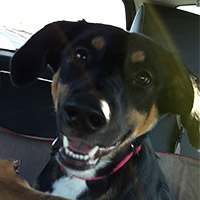The intricacies and ever-evolving strategies of walking a puppy
When I first got Ellie my focus for walks was on tiring her out. It worked well because she was little and needed lots of rest, but after the first few months she grew more energetic. The idea of wearing her out from a walk no long worked and I realized my focus on that aspect was taking away from actual training and so I adjusted.
I also realized that just because we went outside to “take a walk,” doesn’t mean I need to actually bring her anywhere. Instead I started to focus on walking her around the building I live in. Nothing more than loops around the parking lot and neighboring sidewalks. This kept training fresh in my mind and allowed us to repetitively train different elements over and over instead of facing distractions at the park.
But our walking experiences were still combative. She would pull, fight against her harness, get overly excited to meet other dogs, or simply want to sniff every inch of grass. As a result, I began to be more forceful about our walks. They needed to be strict and the pendulum swung in the other direction. Those walks were equally frustrating because neither of us enjoyed it.
If she became too interested in an area I would avoid it. If she really wanted to sniff somewhere it was suddenly off-limits. I still feel this may be a valid strategy to some degree because it forces attention and removes distractions, but it also just seems mean. She’s young and curious, the world is a fascinating place full of interesting smells, I don’t want to be the thing that stops her from experiencing it.
My expectations were wildly optimistic as well, due mostly to the fact that Ellie started out so strong. She’s intelligent, submissive, and excelled at commands within weeks of getting her. But as time moved on she grew increasingly independent and I didn’t adjust my expectations to match this new challenge. As a result, I grew increasingly frustrated with her performance.
Eventually this led me to reassess the situation entirely because something clearly wasn’t working. I implemented a compromise between strict walks and total freedom. If she requested to explore a patch of grass during our walk, she was required to make eye contact, sit, and sometimes perform additional commands before I issued a “roam” command to her. Upon “roam”, I would loosen the leash and wave my hand to indicate she is free to explore. This method has worked fairly well and I continue to use it today with some improvements that I will mention in a future video.
However, I noticed that if she roams too frequently the rest of the walk can become increasingly dysfunctional. This runs contrary to my starting hypothesis in which I thought that lots of early free roam would “get it out of her system”. This has not been the case. You need to strike a continual balance between obedience and freedom.
Overall I’ve found that setting boundaries and defining the walking experience has been most optimal. I try to let her roam frequently, but not too frequently. I deny some of her requests, but I do not forcibly pull her away. Instead I keep the leash taut until she realizes she can’t win. Then I reward her when she comes back to me and we continue our walk peacefully. This middle-ground of free roam and boundaries and patience on my part has worked wonderfully in the past few months.
I also believe the success of this new method was primarily due to a change in how I approached walks. As I mentioned earlier I thought of walks as a chance for Ellie to get fresh air, exercise, socialize, and explore. It’s what I envisioned a good owner would do with their new puppy. I wanted walks to be her time considering how infrequently a dog gets to “make decisions” and feel free. But this wasn’t the case for us. That freedom at this young age simply spiraled into a dog that wanted to misbehave more. Our walks have significantly improved with discipline and more importantly once I started to treat them all as a training exercise.
